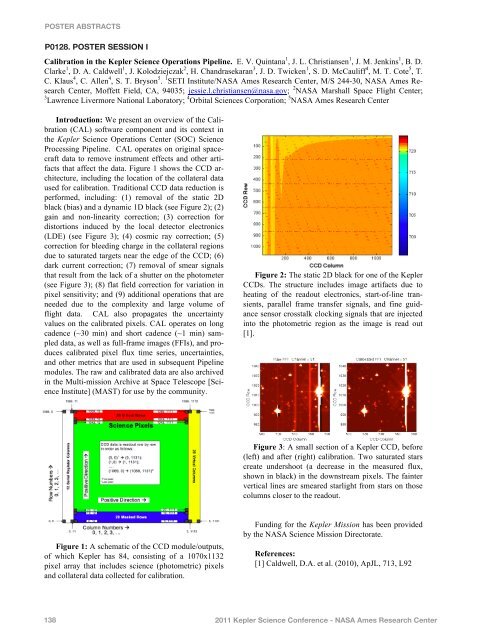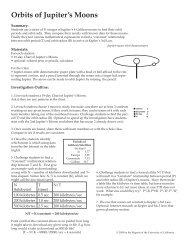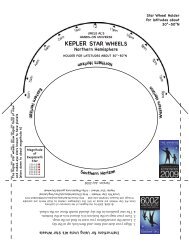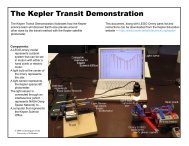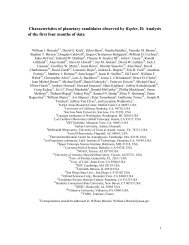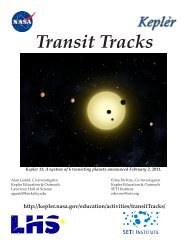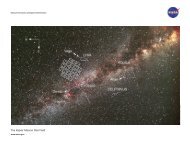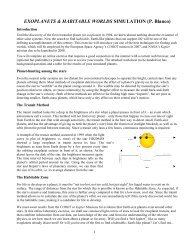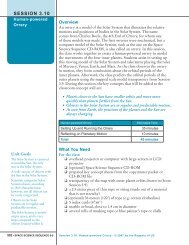Poster Abstracts - Kepler - NASA
Poster Abstracts - Kepler - NASA
Poster Abstracts - Kepler - NASA
- No tags were found...
You also want an ePaper? Increase the reach of your titles
YUMPU automatically turns print PDFs into web optimized ePapers that Google loves.
POSTER ABSTRACTSP0128. POSTER SESSION ICalibration in the <strong>Kepler</strong> Science Operations Pipeline. E. V. Quintana 1 , J. L. Christiansen 1 , J. M. Jenkins 1 , B. D.Clarke 1 , D. A. Caldwell 1 , J. Kolodziejczak 2 , H. Chandrasekaran 3 , J. D. Twicken 1 , S. D. McCauliff 4 , M. T. Cote 5 , T.C. Klaus 4 , C. Allen 4 , S. T. Bryson 5 . 1 SETI Institute/<strong>NASA</strong> Ames Research Center, M/S 244-30, <strong>NASA</strong> Ames ResearchCenter, Moffett Field, CA, 94035; jessie.l.christiansen@nasa.gov; 2 <strong>NASA</strong> Marshall Space Flight Center;3 Lawrence Livermore National Laboratory; 4 Orbital Sciences Corporation; 5 <strong>NASA</strong> Ames Research CenterIntroduction: We present an overview of the Calibration(CAL) software component and its context inthe <strong>Kepler</strong> Science Operations Center (SOC) ScienceProcessing Pipeline. CAL operates on original spacecraftdata to remove instrument effects and other artifactsthat affect the data. Figure 1 shows the CCD architecture,including the location of the collateral dataused for calibration. Traditional CCD data reduction isperformed, including: (1) removal of the static 2Dblack (bias) and a dynamic 1D black (see Figure 2); (2)gain and non-linearity correction; (3) correction fordistortions induced by the local detector electronics(LDE) (see Figure 3); (4) cosmic ray correction; (5)correction for bleeding charge in the collateral regionsdue to saturated targets near the edge of the CCD; (6)dark current correction; (7) removal of smear signalsthat result from the lack of a shutter on the photometer(see Figure 3); (8) flat field correction for variation inpixel sensitivity; and (9) additional operations that areneeded due to the complexity and large volume offlight data. CAL also propagates the uncertaintyvalues on the calibrated pixels. CAL operates on longcadence (~30 min) and short cadence (~1 min) sampleddata, as well as full-frame images (FFIs), and producescalibrated pixel flux time series, uncertainties,and other metrics that are used in subsequent Pipelinemodules. The raw and calibrated data are also archivedin the Multi-mission Archive at Space Telescope [ScienceInstitute] (MAST) for use by the community.Figure 2: The static 2D black for one of the <strong>Kepler</strong>CCDs. The structure includes image artifacts due toheating of the readout electronics, start-of-line transients,parallel frame transfer signals, and fine guidancesensor crosstalk clocking signals that are injectedinto the photometric region as the image is read out[1].Figure 3: A small section of a <strong>Kepler</strong> CCD, before(left) and after (right) calibration. Two saturated starscreate undershoot (a decrease in the measured flux,shown in black) in the downstream pixels. The faintervertical lines are smeared starlight from stars on thosecolumns closer to the readout.Figure 1: A schematic of the CCD module/outputs,of which <strong>Kepler</strong> has 84, consisting of a 1070x1132pixel array that includes science (photometric) pixelsand collateral data collected for calibration.Funding for the <strong>Kepler</strong> Mission has been providedby the <strong>NASA</strong> Science Mission Directorate.References:[1] Caldwell, D.A. et al. (2010), ApJL, 713, L921382011 <strong>Kepler</strong> Science Conference - <strong>NASA</strong> Ames Research Center


